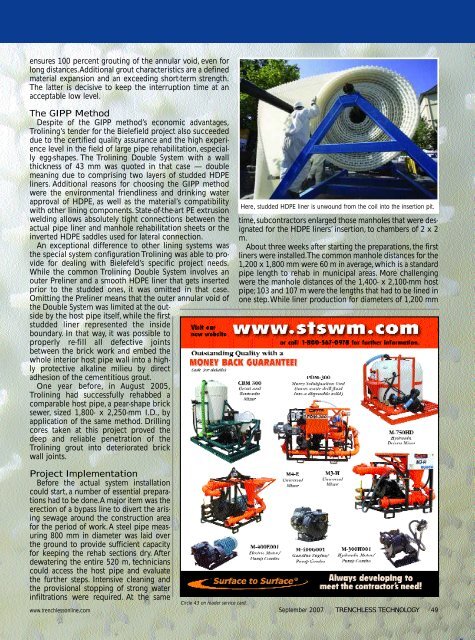Author: Professor, Dr. Dietrich Stein - TrenchlessOnline
Author: Professor, Dr. Dietrich Stein - TrenchlessOnline
Author: Professor, Dr. Dietrich Stein - TrenchlessOnline
You also want an ePaper? Increase the reach of your titles
YUMPU automatically turns print PDFs into web optimized ePapers that Google loves.
ensures 100 percent grouting of the annular void, even for<br />
long distances.Additional grout characteristics are a defined<br />
material expansion and an exceeding short-term strength.<br />
The latter is decisive to keep the interruption time at an<br />
acceptable low level.<br />
The GIPP Method<br />
Despite of the GIPP method’s economic advantages,<br />
Trolining’s tender for the Bielefield project also succeeded<br />
due to the certified quality assurance and the high experience<br />
level in the field of large pipe rehabilitation, especially<br />
egg-shapes. The Trolining Double System with a wall<br />
thickness of 43 mm was quoted in that case — double<br />
meaning due to comprising two layers of studded HDPE<br />
liners. Additional reasons for choosing the GIPP method<br />
were the environmental friendliness and drinking water<br />
approval of HDPE, as well as the material’s compatibility<br />
with other lining components. State-of-the-art PE extrusion<br />
welding allows absolutely tight connections between the<br />
actual pipe liner and manhole rehabilitation sheets or the<br />
inverted HDPE saddles used for lateral connection.<br />
An exceptional difference to other lining systems was<br />
the special system configuration Trolining was able to provide<br />
for dealing with Bielefeld’s specific project needs.<br />
While the common Trolining Double System involves an<br />
outer Preliner and a smooth HDPE liner that gets inserted<br />
prior to the studded ones, it was omitted in that case.<br />
Omitting the Preliner means that the outer annular void of<br />
the Double System was limited at the outside<br />
by the host pipe itself, while the first<br />
studded liner represented the inside<br />
boundary. In that way, it was possible to<br />
properly re-fill all defective joints<br />
between the brick work and embed the<br />
whole interior host pipe wall into a highly<br />
protective alkaline milieu by direct<br />
adhesion of the cementitious grout.<br />
One year before, in August 2005,<br />
Trolining had successfully rehabbed a<br />
comparable host pipe, a pear-shape brick<br />
sewer, sized 1,800- x 2,250-mm I.D., by<br />
application of the same method. <strong>Dr</strong>illing<br />
cores taken at this project proved the<br />
deep and reliable penetration of the<br />
Trolining grout into deteriorated brick<br />
wall joints.<br />
Project Implementation<br />
Before the actual system installation<br />
could start, a number of essential preparations<br />
had to be done.A major item was the<br />
erection of a bypass line to divert the arising<br />
sewage around the construction area<br />
for the period of work.A steel pipe measuring<br />
800 mm in diameter was laid over<br />
the ground to provide sufficient capacity<br />
for keeping the rehab sections dry. After<br />
dewatering the entire 520 m, technicians<br />
could access the host pipe and evaluate<br />
the further steps. Intensive cleaning and<br />
the provisional stopping of strong water<br />
infiltrations were required. At the same<br />
www.trenchlessonline.com<br />
Circle 43 on reader service card.<br />
Here, studded HDPE liner is unwound from the coil into the insertion pit.<br />
time,subcontractors enlarged those manholes that were designated<br />
for the HDPE liners’ insertion, to chambers of 2 x 2<br />
m.<br />
About three weeks after starting the preparations, the first<br />
liners were installed.The common manhole distances for the<br />
1,200 x 1,800 mm were 60 m in average,which is a standard<br />
pipe length to rehab in municipal areas. More challenging<br />
were the manhole distances of the 1,400- x 2,100-mm host<br />
pipe;103 and 107 m were the lengths that had to be lined in<br />
one step.While liner production for diameters of 1,200 mm<br />
September 2007 TRENCHLESS TECHNOLOGY 49








